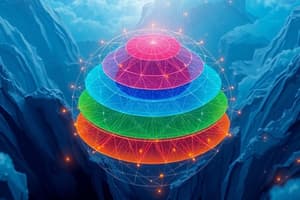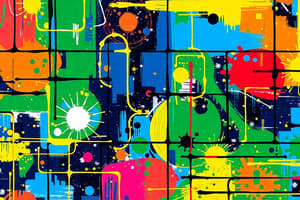Podcast
Questions and Answers
What is the primary difference in the number of layers between the TCP/IP model and the OSI model?
What is the primary difference in the number of layers between the TCP/IP model and the OSI model?
- TCP/IP has four layers while OSI has seven. (correct)
- TCP/IP has three layers while OSI has eight.
- TCP/IP has five layers while OSI has six.
- TCP/IP has six layers while OSI has four.
Which function does the Application Layer of the TCP/IP model perform?
Which function does the Application Layer of the TCP/IP model perform?
- Handles low-level protocols and data transfer.
- Ensures reliable data transfer and sequencing.
- Combines functions of the Application, Presentation, and Session layers of OSI. (correct)
- Manages network routing and addressing.
What is a major characteristic of the OSI model?
What is a major characteristic of the OSI model?
- It is primarily used in real-world implementation.
- It combines several functions into single layers.
- It is generally disregarded in actual network systems.
- It serves as a detailed theoretical reference model. (correct)
What does the Transport Layer in the TCP/IP model focus on?
What does the Transport Layer in the TCP/IP model focus on?
Which layer of the OSI model is responsible for managing sessions between applications?
Which layer of the OSI model is responsible for managing sessions between applications?
How does the Link Layer of the TCP/IP model differ from the Data Link Layer of the OSI model?
How does the Link Layer of the TCP/IP model differ from the Data Link Layer of the OSI model?
Which of the following statements about the OSI Presentation Layer is correct?
Which of the following statements about the OSI Presentation Layer is correct?
What aspect of network communication does the OSI Physical Layer correspond to in the TCP/IP model?
What aspect of network communication does the OSI Physical Layer correspond to in the TCP/IP model?
Flashcards
How many layers do TCP/IP and OSI models have?
How many layers do TCP/IP and OSI models have?
TCP/IP has four layers: Link, Internet, Transport, and Application. OSI has seven layers: Physical, Data Link, Network, Transport, Session, Presentation, and Application.
What is the difference in focus between TCP/IP and OSI model?
What is the difference in focus between TCP/IP and OSI model?
TCP/IP is more practical, used in real-world network implementations and protocol development. OSI is theoretical and serves as a detailed reference model for understanding network functions.
How are TCP/IP and OSI models used?
How are TCP/IP and OSI models used?
TCP/IP is widely adopted in actual network communication systems while OSI model is used more as an educational tool to explain and understand how different network layers interact.
How do TCP/IP and OSI Application layers differ?
How do TCP/IP and OSI Application layers differ?
Signup and view all the flashcards
How are TCP/IP and OSI Transport layers different?
How are TCP/IP and OSI Transport layers different?
Signup and view all the flashcards
What are the differences between TCP/IP Internet and OSI Network layers?
What are the differences between TCP/IP Internet and OSI Network layers?
Signup and view all the flashcards
How do TCP/IP Link and OSI Data Link layers compare?
How do TCP/IP Link and OSI Data Link layers compare?
Signup and view all the flashcards
What are the unique layers in OSI model?
What are the unique layers in OSI model?
Signup and view all the flashcards
Study Notes
Comparing TCP/IP and OSI Models
- TCP/IP model has four layers: Link, Internet, Transport, Application
- OSI model has seven layers: Physical, Data Link, Network, Transport, Session, Presentation, Application
- TCP/IP is practical, used in real-world network implementations
- OSI is theoretical, a detailed reference model for understanding network functions
- TCP/IP is widely used in network communication systems
- OSI is primarily an educational tool to understand network layers
- TCP/IP combines OSI's Application, Presentation, and Session layers into one Application layer, handling high-level protocols and session management
- OSI has separate Application, Presentation, and Session layers, with more distinct functions for each layer
- TCP/IP Transport Layer uses TCP and UDP for communication
- OSI Transport Layer assures reliable data transfer and correct data sequencing
- TCP/IP Internet Layer manages logical addressing and routing (IP)
- OSI Network Layer handles routing, addressing, and data packet forwarding
- TCP/IP Link Layer handles physical network hardware and media access control
- OSI Data Link Layer provides node-to-node data transfer and error correction
- OSI Session Layer manages application sessions and dialogues (absent in TCP/IP)
- OSI Presentation Layer translates data for the Application Layer (absent in TCP/IP)
- OSI Physical layer is equivalent to the Network Interface Layer in TCP/IP dealing with physical network aspects
Studying That Suits You
Use AI to generate personalized quizzes and flashcards to suit your learning preferences.




